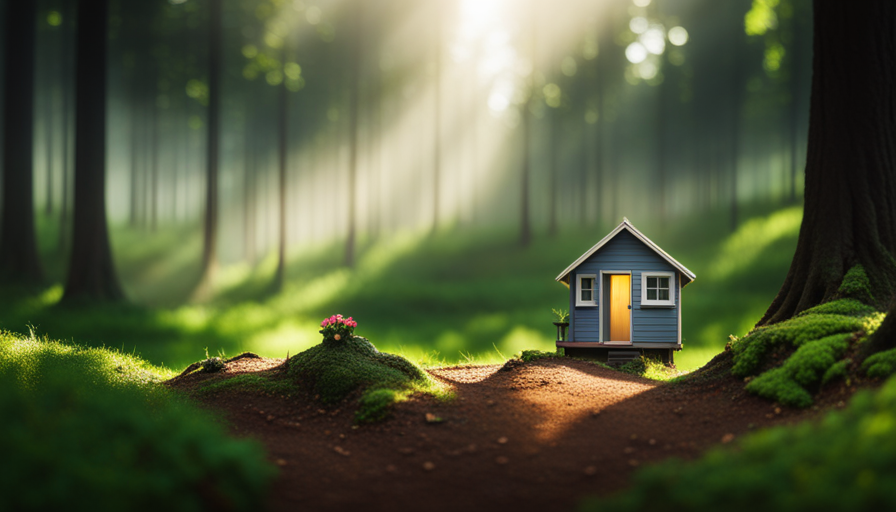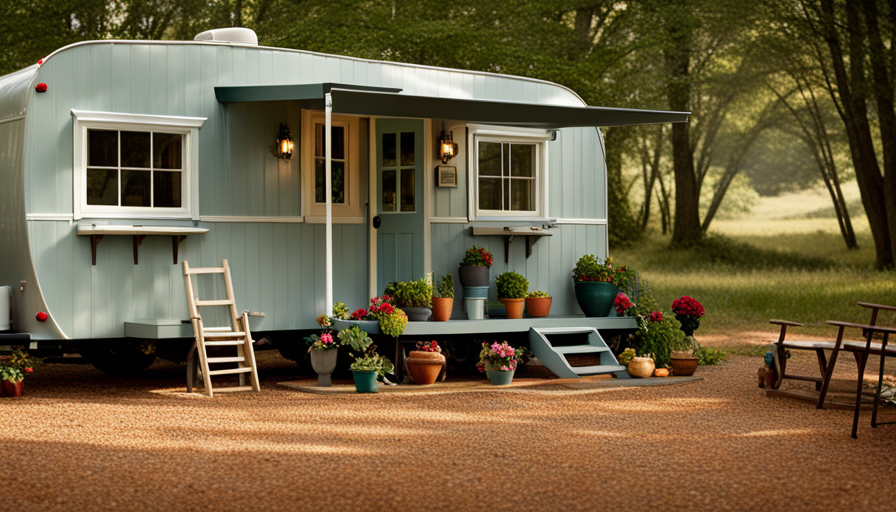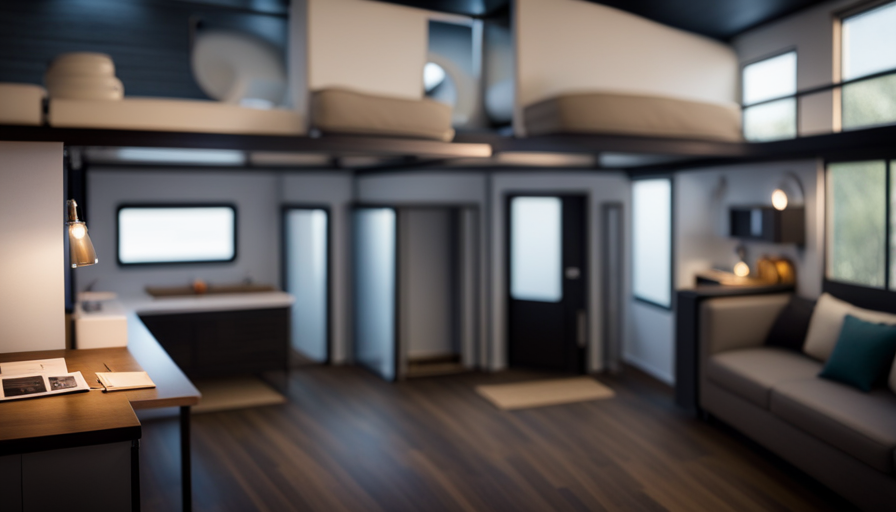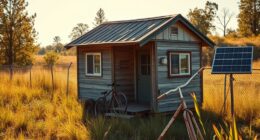In the world of real estate, being big no longer guarantees being the best. Welcome to the world of tiny homes, where simplicity is key. As the saying goes, ‘Good things come in small packages,’ perfectly describing the charm of these compact houses.
But before you jump on the tiny house bandwagon, it’s important to know just how much these little gems will cost you. In this article, we’ll delve into the world of tiny house pricing, exploring the various factors that can affect the cost, breaking down the expenses, and even discussing financing options.
We’ll also touch on the pros and cons of tiny house living, as well as the legal and insurance considerations you’ll need to keep in mind.
So, if you’re ready to downsize and embrace a simpler way of life, let’s dive into the fascinating world of tiny house costs.
Key Takeaways
- The cost of a tiny house can vary depending on factors such as size, materials, and location.
- Customization options and design complexity can increase the overall price.
- Factors such as permits, utilities, and land can affect the final cost of a tiny house.
- Tiny houses have the potential for high resale value and can be a long-term investment.
Types of Tiny Houses
There’s a wide range of options when it comes to the types of tiny houses, each with their own unique features and design elements. Tiny house construction can vary greatly, with some people opting for a DIY approach while others choose to hire professional builders. The materials used can also impact the cost, with options ranging from basic wood to more expensive eco-friendly materials.
Additionally, there are different styles of tiny houses to consider, such as traditional cottages, modern minimalist designs, or even converted shipping containers.
Another factor to consider when looking at the types of tiny houses is whether you want to be part of a tiny house community. These communities offer a sense of community and shared resources, which can be appealing to some individuals. They often have communal spaces, such as gardens or laundry facilities, and provide a support network for those living in tiny houses.
When it comes to cost, the type of tiny house you choose will play a significant role. Factors such as size, materials, and location will all impact the overall price. Additionally, factors affecting cost, such as permits, utilities, and land, will be discussed in the subsequent section.
Factors Affecting Cost
Take into account various factors that impact the price of these compact dwellings. When considering the cost of a tiny house, there are several factors that come into play. Here are some key factors to consider:
-
Size: The size of the tiny house is a significant factor affecting its cost. Generally, the larger the tiny house, the higher the price.
-
Customization: Customization options can greatly impact the cost. Whether you choose to include high-end finishes, custom cabinetry, or unique design elements, these additions can increase the overall price.
-
Location: The cost of land and regulations in different areas can affect the final price of a tiny house. Some locations may have higher costs associated with permits and utility connections.
-
Materials: The quality of materials used in construction can also affect the cost. Opting for sustainable or high-end materials will increase the overall price.
Considering these factors will help you understand the cost breakdown of a tiny house and make informed decisions. Now, let’s delve into the next section where we will explore the cost breakdown in more detail.
Cost Breakdown
To understand the breakdown of expenses, let’s dive into the various factors that contribute to the overall price of your compact abode.
One of the major components of the cost breakdown is the construction materials used. The type and quality of materials you choose will greatly impact the final price of your tiny house. High-end materials such as reclaimed wood, stainless steel appliances, and energy-efficient windows will undoubtedly increase the overall cost. On the other hand, opting for more budget-friendly options like basic lumber and standard fixtures can help keep expenses down.
Additionally, the size of your tiny house plays a significant role in the cost breakdown. The larger the house, the more materials and labor will be required, resulting in higher expenses.
Other factors that contribute to the cost breakdown include the complexity of the design, the location of the build, and the level of customization desired.
Transitioning into the next section about customization options, it’s important to consider that these choices can further impact the overall price of your tiny house. By selecting unique finishes, custom furniture, or specialized features, you can personalize your home to your specific tastes, but these choices may come with additional costs.
Customization Options
When it comes to customizing a tiny house, there are several key points to consider.
First, the interior design and layout can be tailored to fit your specific needs and preferences. This allows you to maximize the use of space and create a functional and comfortable living environment.
Second, energy efficiency upgrades can be incorporated to reduce your environmental footprint and save on utility costs. This includes options such as solar panels, insulation upgrades, and energy-efficient appliances.
Lastly, off-grid capabilities can be added to make your tiny house self-sufficient and independent from traditional utilities. This can include features like water collection systems, composting toilets, and off-grid power solutions.
Overall, the customization options for a tiny house are vast and can be tailored to fit your unique lifestyle and preferences.
Interior Design and Layout
Step into your tiny oasis and let the interior design of your dreams unfold within the cozy confines of your humble abode. When it comes to tiny houses, interior design plays a crucial role in maximizing space and creating a functional yet aesthetically pleasing environment.
Keeping up with the latest interior design trends can help you personalize your tiny house and make it feel like home. From minimalist and Scandinavian-inspired designs to rustic and bohemian themes, there are endless possibilities to explore.
Clever storage solutions, multi-purpose furniture, and open floor plans are some popular approaches to maximize space in tiny houses. These design choices not only create a visually appealing space but also ensure that every inch of your tiny house serves a purpose.
As we delve into energy efficiency upgrades, it’s important to consider how these design elements can contribute to a sustainable and eco-friendly living experience.
Energy Efficiency Upgrades
One way to make your tiny oasis more sustainable and eco-friendly is by incorporating energy efficiency upgrades into the design and layout. By utilizing energy-efficient technologies and sustainable materials, you can reduce your carbon footprint and lower your energy consumption. Here are some energy efficiency upgrades that can be incorporated into your tiny house:
| Upgrade | Benefits |
|---|---|
| Solar panels | Generate renewable energy for your home |
| Insulation | Reduce heat loss and increase energy efficiency |
| LED lighting | Lower energy consumption and longer lifespan |
| Energy-efficient appliances | Reduce electricity usage and save money |
These upgrades not only contribute to a greener lifestyle but also help you save on energy costs in the long run. Transitioning to the next section, exploring the off-grid capabilities of a tiny house opens up even more possibilities for sustainable living.
Off-grid Capabilities
Incorporating off-grid capabilities into your tiny oasis allows for a more self-sufficient and environmentally conscious way of living. Here are three key features that make off-grid living in a tiny house sustainable:
-
Solar Power: Installing solar panels on the roof of your tiny house allows you to generate your own electricity. This renewable energy source not only reduces your carbon footprint but also provides you with a reliable power supply.
-
Rainwater Harvesting: By collecting and storing rainwater, you can reduce your reliance on traditional water sources. This sustainable practice not only conserves water but also helps you live more independently.
-
Composting Toilets: Instead of relying on a traditional sewage system, off-grid tiny houses often incorporate composting toilets. These toilets break down waste into compost, which can be used as fertilizer. This eco-friendly solution not only saves water but also contributes to a more sustainable lifestyle.
By incorporating these off-grid capabilities, you can live a more sustainable life in your tiny house. Transitioning into the subsequent section about ‘financing and budgeting,’ it’s important to consider the cost of these sustainable features.
Financing and Budgeting
When it comes to financing a tiny house, there are several options available to consider. Loans and financing options can provide the necessary funds to build or purchase a tiny house.
Creating a realistic budget is essential to ensure that all costs are accounted for, including materials, labor, and any additional expenses.
Additionally, cost-saving tips and tricks can help individuals save money throughout the process, making their tiny house dream more affordable.
Loans and Financing Options
There are various loans and financing options available to help individuals afford the cost of a tiny house, with interest rates typically ranging from 3% to 8%. These options cater to different needs and circumstances, providing flexibility for those seeking financing for their tiny house project.
Here are three common financing options for tiny houses:
-
Personal Loans: These loans are unsecured and can be used for various purposes, including financing a tiny house. They typically have fixed interest rates and repayment terms, providing stability and predictability.
-
RV Loans: If your tiny house is on wheels and meets certain criteria, you may qualify for an RV loan. These loans are specifically designed for recreational vehicles and can be a viable option for financing your tiny house.
-
Construction Loans: For individuals building their own DIY tiny houses, construction loans can provide the necessary funds during the building process. These loans typically have a draw schedule based on project milestones.
When considering loans and financing options, it’s important to carefully review the requirements and terms to ensure they align with your specific needs and goals. This understanding will contribute to creating a realistic budget for your tiny house project.
Creating a Realistic Budget
To create a realistic budget for your tiny house project, you’ll need to carefully consider and account for all the necessary expenses involved. Realistic budgeting tips can help you stay on track and avoid any unexpected costs.
One important aspect is finding affordable materials. Look for local suppliers or online marketplaces where you can source materials at a lower cost. Consider using reclaimed or recycled materials, which can be both environmentally friendly and cost-effective.
Additionally, try to prioritize the essentials and avoid unnecessary luxuries that can quickly add up. Keep in mind that DIY projects can save you money, but be realistic about your skills and the time it will take to complete each task.
By finding affordable materials and being mindful of your spending, you can create a budget that works for you.
In the subsequent section about cost-saving tips and tricks, we’ll explore more ways to save money during your tiny house project.
Cost-saving Tips and Tricks
Consider prioritizing the essentials and avoiding unnecessary luxuries in order to save money during your tiny house project.
There are several cost-cutting strategies you can employ to keep your expenses down. One option is to take on a do-it-yourself (DIY) building approach. This allows you to save on labor costs by doing the work yourself or with the help of friends and family.
Additionally, sourcing materials from salvage yards or repurposing items can significantly reduce expenses. Another tip is to focus on functional and efficient design, maximizing the use of every square inch. This can help minimize the need for excess materials and save money in the long run.
By implementing these cost-saving measures, you can create a beautiful and affordable tiny house.
Moving forward, it’s important to consider the ongoing maintenance and utility costs associated with your tiny house.
Maintenance and Utilities
You’ll need to budget for regular maintenance and utility expenses when owning a tiny house. Despite their small size, tiny houses still require ongoing maintenance to keep them in good condition. This includes tasks such as cleaning the gutters, checking for leaks, and maintaining the HVAC system.
While the cost of maintenance will vary depending on the specific needs of your tiny house, it’s important to set aside funds for these expenses.
In addition to maintenance costs, utility expenses are another aspect to consider. Since tiny houses are typically smaller and more energy-efficient than traditional homes, utility bills are generally lower. However, you’ll still need to budget for electricity, water, and possibly propane or gas if your tiny house is not connected to the grid. It’s important to carefully monitor your energy usage and find ways to conserve electricity and water to keep costs down.
As you can see, owning a tiny house comes with its own set of maintenance and utility expenses. However, these costs are generally lower compared to larger homes.
In the next section, we will explore the pros and cons of tiny house living, which will give you a better understanding of whether it is the right choice for you.
Pros and Cons of Tiny House Living
Living in a tiny house has its advantages and disadvantages. On one hand, downsizing to a smaller space can lead to a simpler and more affordable lifestyle. It allows for financial freedom, as the cost of purchasing and maintaining a tiny house is significantly lower compared to a traditional home. Additionally, the reduced space forces you to declutter and prioritize what’s truly important, promoting a minimalist mindset.
However, there are challenges that come with living in a small space. Limited storage can be a drawback, requiring creative solutions to maximize every inch. Privacy may also be compromised, as there’s less room to retreat to. Additionally, if you enjoy hosting gatherings or have a large family, the lack of space might not be suitable for your needs.
Despite these challenges, many people find that the benefits of tiny house living outweigh the drawbacks. It offers a chance to live more sustainably, with a smaller carbon footprint and reduced energy consumption. It also encourages a closer connection with nature, as tiny houses often prioritize outdoor living spaces.
Moving on to the next section on insurance and legal considerations, it’s important to address these factors when considering the transition to tiny house living.
Insurance and Legal Considerations
Navigating the legal and insurance aspects of tiny house ownership can be a complex maze, requiring careful research and understanding of regulations.
When it comes to insurance considerations, it’s important to find a provider that offers coverage specifically for tiny houses. Not all insurance companies offer policies tailored to these unique dwellings, so it’s crucial to do thorough research and find one that understands the specific needs and risks associated with tiny houses.
Additionally, it’s important to consider the legal requirements of owning a tiny house. Each state and municipality may have different regulations regarding zoning, building codes, and permits. It’s essential to check with local authorities to ensure compliance with these requirements. Failure to do so can result in fines or even the forced removal of the tiny house.
Understanding both the insurance considerations and legal requirements of tiny house ownership is crucial to protect your investment and ensure a smooth and hassle-free living experience.
As we move into the next section about resale value and investment potential, it’s important to consider these factors when making decisions about your tiny house.
Resale Value and Investment Potential
Considering the potential for a high return on investment and the growing popularity of tiny houses, it’s worth exploring the resale value and financial benefits they can offer. Tiny houses have gained significant attention in recent years, and their appeal extends beyond just the minimalist lifestyle. Many people see them as a viable long-term investment option.
One key factor to consider when looking at the resale value of tiny houses is their affordability compared to traditional homes. While the initial cost of a tiny house may be lower, it’s important to note that their value can appreciate over time. This is particularly true if you choose high-quality materials and design elements that stand the test of time.
To provide a clearer picture, let’s take a look at a table that compares the average resale value of a standard-sized house to that of a tiny house over a 10-year period:
| Standard-Sized House | Tiny House | |
|---|---|---|
| Initial Cost | $250,000 | $80,000 |
| Resale Value | $300,000 | $120,000 |
| Appreciation | $50,000 | $40,000 |
The table shows that while the initial cost of a tiny house is significantly lower, it still has the potential for a substantial return on investment. Additionally, the growing demand for tiny houses in the real estate market further supports their long-term investment potential.
Tiny houses offer a unique opportunity for individuals looking to invest in real estate. With their potential for a high resale value and the increasing popularity of minimalist living, they can be a smart long-term investment choice.
Frequently Asked Questions
Are tiny houses considered a good investment in today’s real estate market?
Tiny houses are a hot trend, but are they a good investment? According to a recent study, 78% of tiny homeowners have no mortgage, thanks to flexible financing options. However, living in a tiny house has its pros and cons.
What are the legal considerations and regulations surrounding living in a tiny house?
Legal considerations and zoning regulations are important factors to consider when living in a tiny house. It is crucial to ensure that the construction and placement of the tiny house comply with local laws and regulations.
How does the resale value of a tiny house compare to traditional homes?
The resale value of a tiny house may be lower compared to traditional homes due to limited demand, smaller size, and unconventional nature. However, for those seeking a unique lifestyle and potential investment, tiny houses offer an alternative with potential for appreciation.
Are there any special insurance requirements for tiny houses?
Special insurance coverage is necessary for tiny houses due to their unique nature. This coverage typically includes liability coverage, property coverage, and coverage for movable structures. The insurance cost for tiny houses varies depending on factors such as location and value.
What are the common maintenance and utility costs associated with living in a tiny house?
Common maintenance costs for living in a tiny house include regular cleaning, repairs, and upkeep of systems. Utility expenses may vary but typically include electricity, water, and propane for heating and cooking.
Conclusion
To sum it up, diving into the world of tiny houses can be like stepping into a treasure chest of possibilities. Just like a hidden gem waiting to be discovered, these compact homes offer a unique and cost-effective way of living.
From the variety of types available to the numerous customization options, there’s something for everyone. However, it’s important to consider factors such as financing, maintenance, and legal considerations before taking the plunge.
With careful planning and consideration, a tiny house can become your own little oasis in this vast world.
Hi, I’m Emma. I’m the Editor in Chief of Tiny House 43, a blog all about tiny houses. While tree houses are often associated with childhood, they can be the perfect adult retreat. They offer a cozy space to relax and unwind, surrounded by nature. And since they’re typically built on stilts or raised platforms, they offer stunning views that traditional homes simply can’t match. If you’re looking for a unique and romantic getaway, a tree house tiny house might just be the perfect option.










